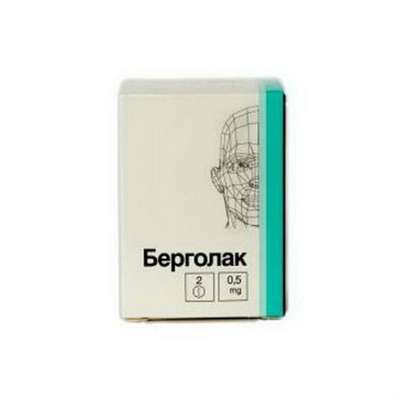Instruction for use: Bromocriptine
I want this, give me price
The Latin name of the substance Bromocriptine
Bromocriptinum (genus. Bromocriptini)
Chemical name
(5-alpha) -2-Bromo-12'-hydroxy-2 '- (1-methylethyl) -5' - (2-methylpropyl) ergotamane-3 ', 6', 18-trione (as mesylate)
Gross Formula
C32H40BrN5O5
Pharmacological group
Dopaminomimetics
The nosological classification (ICD-10)
D24 Benign neoplasm of breast: Benign neoplasm of mammary gland; Benign mammary gland disease; Neoplastic processes in the mammary gland; Tumors of the mammary glands; Papilloma of the ducts of the mammary gland
D35.2 Benign neoplasm of pituitary gland: Pituitary adenoma; Prolactinomas; Macro-prolaktinoma; Microprolactinoma; Prolactinoma; Somatoliberinoma; Aumada del Castillo Syndrome Tumors of the pituitary and suprasellar region
D44.3 Neoplasm of uncertain or unknown pituitary nature: Macropropolactinoma; Microprolactinoma; Prolactinoma; Somatoliberinoma; Prolactinomas
E22.0 Acromegaly and pituitary gigantism: Pituitary gigantism; Acromegaly; Dysfunction of growth hormone secretion
E22.1 Hyperprolactinaemia: Hyperprolactinemia medication; Hyperprolactinaemia with infertility; Hyperprolactinemia in men; Hyperproduction of prolactin; Idiopathic hyperprolactinemia; Chiari-Frommel Syndrome; Forbes-Albright Syndrome; Tumor galactorrhea; Argonsa del Castillo Syndrome; Forbes-Albright Syndrome
G20 Parkinson's disease: A trembling paralysis; Idiopathic Parkinsonism; Parkinson's disease; Symptomatic Parkinsonism
G21 Secondary Parkinsonism: Medicinal Parkinsonism; Parkinsonism; Parkinsonism symptomatic; Disorders of extrapyramidal system; Parkinson's Syndrome
N60.1 Diffuse cystic mastopathy: Benign cystic change in mammary glands; Cystic fibrosis mastopathy; Fibrous-cystic mastopathy; Pre-cancerous condition of mammary glands; Benign mammary gland disease; Benign breast tumor
N94.3 Premenstrual tension syndrome: Pronounced premenstrual syndrome; Menstrual psychosomatic disorder; Menstrual syndrome; Premenstrual tension; Premenstrual status; Premenstrual period; Premenstrual syndrome; Menstruation syndrome
N94.6 Unspecified Dysmenorrhea: Pain in menstruation; Functional disorders of the menstrual cycle; Functional disorders of the menstrual cycle; Menstrual cramps; Menstruation disorder; Pain during menstruation; Painful irregular menstruation; Algodismenorea; Algomenorea; Pain syndrome with smooth muscle spasms; Pain syndrome with smooth muscle spasms (renal and biliary colic, intestinal spasm, dysmenorrhea); Pain syndrome with spasms of smooth muscles of internal organs (renal and biliary colic, intestinal spasm, dysmenorrhea); Disalgomenorrhea; Dysmenorrhea; Dysmenorrhea (essential) (exfoliative); Menstrual disorder; Menstruation painful; Metrorrhagia; Violation of the menstrual cycle; Menstrual irregularities; Prolactin-dependent disorder of the menstrual cycle; Prolactin-dependent disorder of menstrual function; Pain syndrome with spasms of smooth muscles of internal organs; Spastic dysmenorrhea; Primary disalgomenorrhea
N97 Female infertility: Female infertility in anovulation; Hyperprolactinemic infertility; Hyperprolactinaemia with infertility; Endocrine infertility; Infertility due to hypothalamic-pituitary dysfunction; Infertility infertility; Infertility; Infertility on the background of hyperprolactinaemia; Functional infertility; Marriage is infertile; Infertility of ovarian genesis; Stimulation of the growth of a single follicle
CAS Code
25614-03-3
Characteristics of the substance Bromocriptine
Semi-synthetic ergot alkaloid derivative ergocryptine (2-bromo-alpha-ergocryptine). Crystalline powder, very slightly soluble in water, moderately soluble in ethanol.
Pharmacology
The pharmacological action is antiparkinsonian, dopaminomimetic.
Stimulates dopamine D2 receptors in the brain. Inhibits the incretion of prolactin and suppresses physiological lactation, normalizes menstrual function; Facilitating dopaminergic transmission in the nigrostriral system, reduces the severity of parkinsonian symptoms; Reduces the concentration of somatotropin in the blood in patients with acromegaly, reduces depressive symptoms.
After ingestion, 30% is absorbed. Of great importance is the effect of the "first passage" through the liver. Cmax in the blood is determined after 2-3 hours. The connection with plasma albumins is 90-96%. It is excreted mainly with bile (86%), with urine only 2.5-5.5%.
Application of substance Bromocriptine
Dysmenorrhea and infertility in background overproduction prolactin luteal phase insufficiency, hyperprolactinemia (including as a result of psychotropic and antihypertensive agents), prolactinoma (s syndrome, persistent amenorrhea-galactorrhea in females and hypogonadism in men), the necessity of suppressing puerperal lactation, premenstrual syndrome , acromegaly, benign breast disease, benign nodular and / or mammary cystic changes, including Fibrocystic mastopathy; Parkinson's disease, Parkinsonism.
Contraindications
Hypersensitivity, preeclampsia, a disease of the cardiovascular system, arterial hypo- or hypertension, recent myocardial infarction, valvular heart disease in history, pronounced dysrhythmia, endogenous psychosis, liver failure.
Restrictions on the use
Erosive-ulcerative lesions of the gastrointestinal tract, pregnancy (I trimester).
Application in pregnancy and lactation
The action category for fetus by FDA is B.
Side effects of Bromocriptine
Nausea, vomiting, dry mouth, constipation, decreased blood pressure, whitening of the fingers and toes when cooled, headache, dizziness, drowsiness, irritability, blurred vision, swelling of the mucous membranes of the nose, nasal congestion, allergic reactions, cramps in the calf muscles; Rarely - orthostatic hypotension, collapse.
Interaction
Incompatible with MAO inhibitors and alcohol. Reduces the effect of neuroleptics, oral contraceptives, reduces akinesia caused by reserpine.
Overdose
Symptoms: headache, hallucinations, lowering blood pressure.
Treatment: parenteral administration of metoclopramide.
Routes of administration
Inside.
Precautions for the substance Bromocriptine
Periodic monitoring of blood pressure, liver and kidney function is recommended.
Before beginning treatment of benign breast diseases, it is necessary to exclude the presence of a malignant tumor of the same localization.
With caution appoint people whose work requires increased attention and speed of decision-making.

 Cart
Cart





